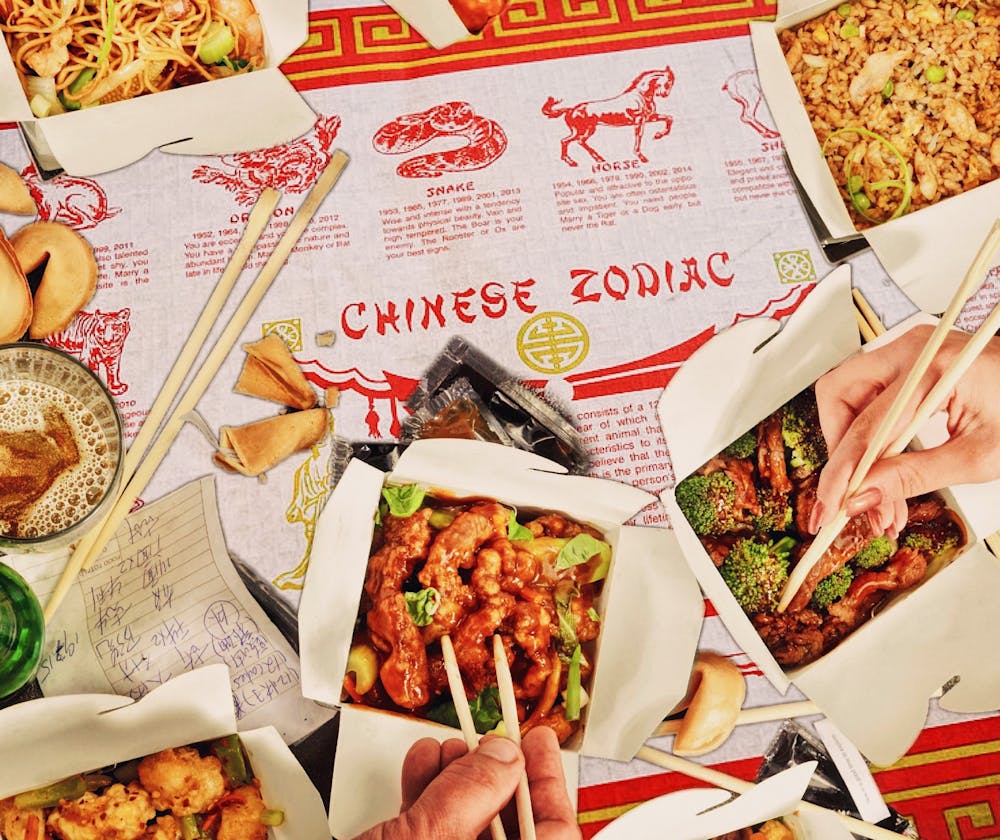I know everybody says it, but my parents are the best cooks in the world. I grew up in a household where authentic Chinese cuisine graced my dinner plate every night: rich and tomatoey oxtail soup, spicy mapo tofu, and soft pork and cabbage dumplings expertly folded by my mother on sunny weekend afternoons. There’s nothing better than waking up on Sunday mornings to the sound of potstickers sizzling next to eggs on the frying pan.
Nothing at Chinese restaurants can even compare. And yet, every time my dad wants to get takeout, his first suggestion is always the same: “Chinese?”
I have been to every single Chinese restaurant in my hometown more times than I can count, from China Express, to Far East, to Great Wall, to China Garden. A trip to the local Chinese buffet was a weekly occurrence in my childhood. Every Saturday, I remember parking in front of the flickering, neon red “CHEF WANG’S” sign, walking down the buffet line with a warm plate in hand, and sliding into a cushy black booth to chow down on cheese wontons, sweet and sour chicken, and broccoli and beef.
Trips to China to visit family made me realize that most dishes that are Chinese American don’t even exist in the mainland. Yet my parents rarely wanted to go anywhere other than Chinese restaurants, even when I begged for Mexican, Italian, or plain old cheeseburgers. For most of my life, I asked them the same question over and over: why go out to eat fake Chinese food when we already have the real deal at home?
“We can’t get used to American food like you can,” my mom said. “Even though it’s not the same, Chinese takeout is the closest thing to what we’d have back home.”
Not our home in America, but their home in China. I didn’t understand it then, but our difference in palate was just the beginning of a bigger divide in our cultural experiences.
My middle school and high school were over 80% white. As one of only a handful of Asian kids in a suburban pocket of Tennessee, I tried all sorts of small, subconscious ways to assimilate. For a while, this meant scoffing at Chinese dishes. When I went to friends’ houses, I delighted in eating the American foods I never had access to at home, like pasta, barbecue, and casseroles.
My parents didn’t feel the same pressures. They’d spent half their lives in a country thousands of miles away. Living in the U.S. for years didn’t change the fact that they were in a strange land, and little reminders of home were very important. When they went to Chinese restaurants, they knew whatever they ate would feel familiar. More often than not, they could give their order in Mandarin to the store owners, who were usually Chinese immigrants themselves. My parents rarely had opportunities to speak their language outside the house. I’d always see them smile as they made small talk about where they were from in China, and when they immigrated to the U.S. The connection went both ways—the owners never skimped on sauce, and they’d sometimes sneak an extra egg roll into our takeout.
In high school, I learned that the tie between my family and Chinese restaurants went even deeper than feelings of familiarity and personal tastes. One day, we’d just ordered takeout from a spot called Fortune Express near Nashville. My mom and I were waiting for my dad to come back with the food when she casually mentioned that our family used to own the restaurant. Years before I was born, while both of my parents were going back to school, they opened their own restaurant to pay bills and tuition. The money they got from serving fried rice gave them the time they needed to find jobs in their fields with foreign qualifications. Many of the parents of my Chinese American friends had the same experience—working at Chinese restaurants was a big part of their immigration story.
Curious, I looked into the greater history of Chinese restaurants. I found that it’s a vital thread in the journey of Chinese Americans finding acceptance in a new country. In the early days of the cuisine, white Americans treated the food with suspicion, alleging that restaurant conditions were dirty and the origins of the meat were untrustworthy. This went hand in hand with more directly racist sentiments against Chinese Americans, culminating in the 1882 Chinese Exclusion Act, which banned a large number of Chinese workers from immigrating to the U.S. But over time, Chinese restaurateurs were able to transform a foreign fare into one of the most popular cuisines in the country. Dishes like chop suey were born out of the ingenuity of immigrants who figured out how to adapt, creating a distinct set of dishes that take inspiration from both Chinese and American tastes.
“On every day of the Lunar calendar, it seems there’s nothing quite as all–American as some good Chinese food,” wrote food historian Emelyn Rude in Time Magazine.
In the present day, Chinese American cuisine has provided my family a sense of comfort, bridging the gap between two cultures in a powerful—and delicious—way. My parents and I may have different palates, but we can always agree to sit down with some chow mein.
One of the best parts of studying in Philadelphia is access to all kinds of diverse and authentic Asian cuisine, something I was never able to experience in my hometown. But every once in a while, I still get the craving for some egg drop soup and veggie lo mein. Every time I see a takeout box or crack open a fortune cookie, I remember nights spent eating out with my family, and the Chinese restaurant that built up my family before I was born.
The food may not strictly be authentic, but the history behind it is. And let’s be real: it’s also just damn good.







